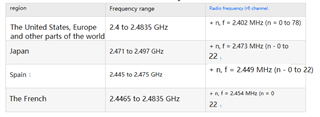Hi,
IC nRF52833
sdk:nRF5_SDK_17.1.0
1. Does BLE have the concept of signaling test mode and non-signaling test mode?
2. Is DTM in signaling mode or non-signaling mode?
3. How do I enter the signaling test mode?
4. How to enter non-signaling test mode in BLE?
5.How to configure the RF frequency range in the program:
In Japan, for example:
In Spain, for example:
In France, for example:

6.Can you turn off part of the RF frequency range, because some part of the frequency range interference is too large


